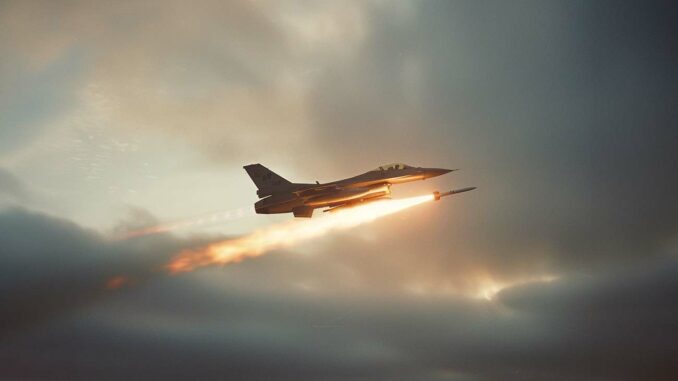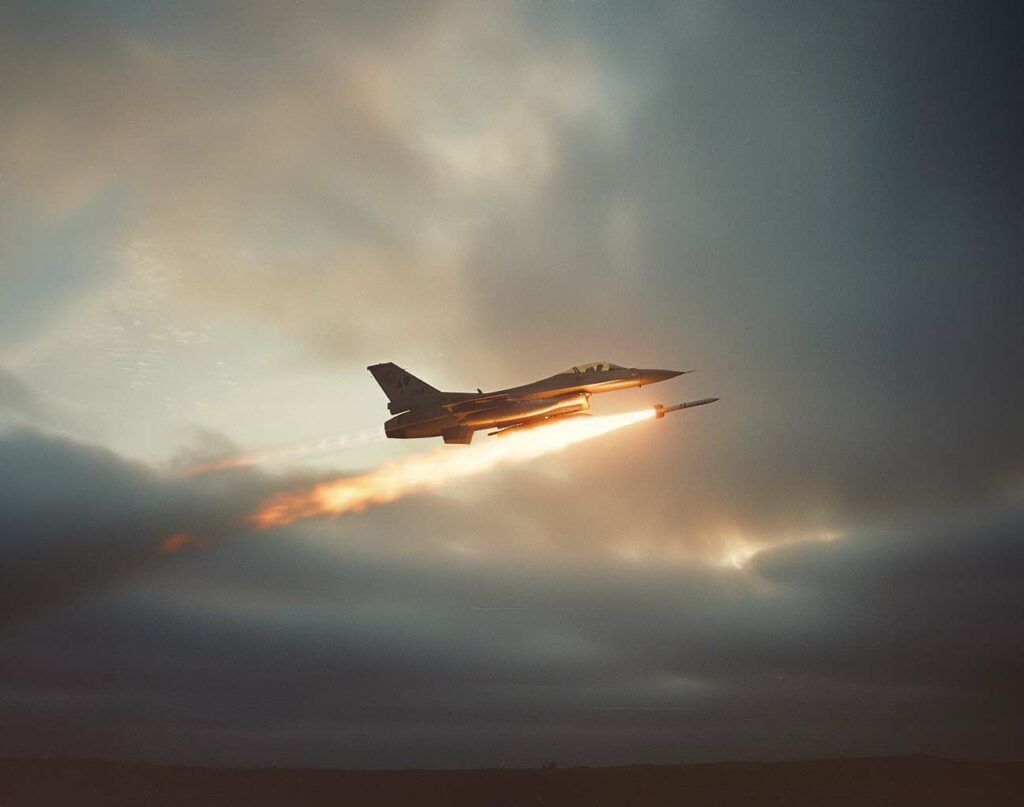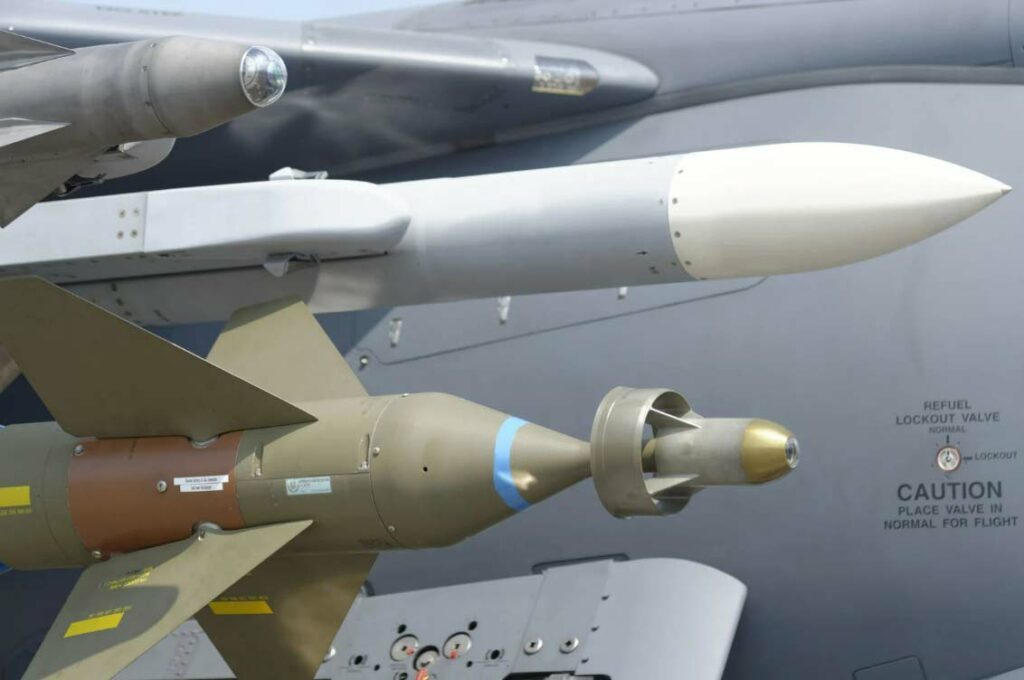
Discover how air-to-air missiles work: their guidance technology, range, impact and latest advances. A comprehensive guide to their crucial role in defense.
Air-to-air missiles are guided weapons designed to be launched from aircraft to shoot down other aerial targets. Usually powered by jet engines or solid rocket boosters, these missiles are equipped with guidance systems that can be radar, infrared or even laser-based, enabling them to track and hit targets at high speed and over long distances. Models vary in size, from small missiles for close combat, such as the AIM-9 Sidewinder with its 3-meter length and a range of around 18 to 35 kilometers, to longer, heavier missiles designed for long-range engagements, such as the Meteor, which can reach a target over 100 kilometers away.
As part of modern air defense, air-to-air missiles play a crucial role in enabling armed forces to maintain air superiority and protect airspace against enemy threats. Their ability to rapidly intercept hostile aircraft or other missiles considerably enhances the security of national territories and forces deployed abroad. For example, during the Nagorno-Karabakh conflict in 2020, the effective use of missile systems had a significant impact on air strategies, demonstrating their strategic and tactical value in real combat situations.

Basic principles of an air-to-air missile
Description of air-to-air missile types
Air-to-air missiles fall into two main categories according to their guidance system: radar-guided and infrared-guided. Radar-guided missiles, such as the AIM-120 AMRAAM (Advanced Medium-Range Air-to-Air Missile), use on-board radar to detect and track the target before getting close enough for interception. These missiles can engage targets up to 120 kilometers away, offering a significant advantage in long-range combat.
In contrast, infrared-guided missiles, such as the AIM-9 Sidewinder, detect the heat emitted by the target (typically aircraft exhaust) and are better suited to close-range combat. Their range is generally shorter, around 18 to 35 kilometers, but they benefit from the “fire and forget” advantage, allowing the pilot to concentrate on other threats or missions once the missile has been launched.
Key components
- Propulsion : Air-to-air missiles typically use solid-fuel rocket motors for propulsion, providing the speed needed to reach and maintain contact with fast, agile targets. For example, the engine of the Meteor missile generates sufficient thrust to enable the missile to track targets maneuvering at supersonic speeds over long distances.
- Guidance system: Essential to missile operation, the guidance system often includes radar, infrared sensors, and sometimes laser or GPS guidance systems. Each system has its own specific features: radar enables high accuracy even in adverse weather conditions, while infrared guidance avoids the need for constant radar illumination of the target, thus reducing the risk of detection.
- Warhead: The part responsible for the missile’s destructive impact, the warhead, varies according to the mission. Warheads can be fragmentation warheads, designed to maximize damage against aerial targets, bursting into multiple fragments on approach or impact to increase the probability of neutralizing the target. The weight of the warhead is typically proportional to the size of the missile, ranging from a few kilograms to more substantial for longer-range missiles.
Guidance technology
Radar guidance: operation and advantages
Radar guidance of air-to-air missiles works by emitting radio waves that bounce off potential targets to determine their position, speed and trajectory. This technique enables precise detection even at great distances, which is crucial for long-range engagements. For example, the AIM-120 AMRAAM missile can engage targets up to 120 kilometers away thanks to its active radar, enabling it to track and intercept targets independently after launch. The radar’s major advantage is its ability to operate effectively in a variety of weather conditions and through environmental interference, making it a reliable tool for airborne surveillance and combat.
Infrared guidance: principles and effectiveness
Infrared-guided missiles use sensors to detect the thermal energy emitted by targets, usually the hot exhaust gases of aircraft engines. This method enables high precision targeting of enemy aircraft without the need for a constant radar signal, thus minimizing enemy detection of the missile. A notable example is the AIM-9 Sidewinder, whose sensors can detect and lock on to a heat source several kilometers away. The effectiveness of this technology lies in its ability to engage targets with great precision in close combat, making these missiles extremely dangerous in direct confrontations.
Other targeting technologies
In addition to radar and infrared systems, other targeting technologies are employed to enhance the effectiveness of air-to-air missiles. Laser guidance, for example, involves illuminating a target with a laser beam, which the missile follows until impact. This method is highly accurate, but requires the target to remain in the laser transmitter’s field of view until the missile strikes. GPS guidance systems are also used, particularly in situations where geographical precision is essential. They enable the missile to be programmed to reach specific coordinates, which is useful for engaging targets at predetermined locations or for adjusting the missile’s trajectory in flight. Although less common than radar or infrared, these technologies offer significant complementary capabilities in the field of guided weapons.
Range and operational capabilities
Factors influencing missile range
The range of an air-to-air missile is determined by a number of technical and environmental factors. Firstly, propulsion plays a key role: more powerful engines and advanced aerodynamic designs make it possible to reach more distant targets. For example, the Meteor missile uses a ramjet propulsion engine that gives it a superior range of up to 200 kilometers, far beyond that of traditional solid-fuel systems.
Atmospheric conditions such as air density, humidity and temperature can also affect missile range. For example, colder, denser air can improve engine performance but also increase aerodynamic drag. In addition, launch strategies, such as high-altitude firing, often increase the missile’s range by reducing atmospheric friction.
Mission diversity and missile adaptability
Air-to-air missiles are designed for a variety of missions, requiring adaptability to different combat situations. Some missiles, such as the AIM-120 AMRAAM, are optimized for long-range interception thanks to their ability to be guided independently after launch, allowing the pilot to reposition or focus on other threats.
Other missiles, such as the AIM-9X Sidewinder, are designed for close combat, offering extreme maneuverability and lock-on capability after launch, suitable for direct confrontation and complex tactical environments. Their design also enables integration on a wide range of air platforms, underlining the importance of operational flexibility to respond effectively to diverse combat scenarios.
A missile’s ability to adapt to specific missions is crucial to air defense strategy, enabling armed forces to respond accurately and effectively to constantly evolving threats. This adaptability is often achieved through software upgrades and modular enhancements, enabling existing systems to remain relevant in the face of technological advances and new operational requirements.

Impact and efficiency
Evaluating destructive power
The destructive power of an air-to-air missile depends mainly on its payload, i.e. the warhead it carries. Warheads can vary from high-explosive to fragmentation charges designed to maximize damage against specific targets. For example, the warhead on an AIM-120 AMRAAM weighs around 18 kilograms and is designed to detonate close to the target, projecting metal fragments to increase the probability of target destruction.
Destructive power is also influenced by the missile’s accuracy. An advanced guidance system that can precisely adjust the missile’s path to final impact significantly improves the chances of reaching and neutralizing the target. This is essential, especially in scenarios where the targets are advanced air threats capable of high-speed maneuvers.
Missile effectiveness evaluation criteria
The effectiveness of an air-to-air missile is measured by several key criteria:
- Accuracy: The missile’s ability to reach and hit its intended target without error. Accuracy is crucial, especially when it is necessary to neutralize targets at long range or which execute complex evasive maneuvers.
- Reliability: The missile’s consistent performance under various operational conditions. A reliable missile must perform as expected, regardless of climatic variations or enemy electronic interference.
- Range: The maximum distance at which the missile can engage a target. A longer range allows engagement at a safe distance, which is a significant strategic advantage.
- Maneuverability : The missile’s ability to change direction in response to target movements during the terminal phase of the approach. Maneuverability is particularly important in close air combat, where targets can rapidly change trajectory.
- Cost-effectiveness: The evaluation of cost per shot compared to operational effectiveness. Military forces are looking for solutions that offer a good balance between cost and operational performance to optimize their defense budget.
Recent advances and future developments
Recent technological innovations in missile design
Recent advances in air-to-air missile technology focus mainly on improving accuracy, range and survivability in hostile environments. For example, the development of more advanced propulsion systems, such as the ramjet engines integrated into missiles like the Meteor, offers greater range and increased speed, enabling interception at distances of up to 200 kilometers.
In addition, the integration of artificial intelligence (AI) into guidance systems enhances the ability of missiles to make autonomous decisions in real time. This includes the ability to analyze and prioritize targets according to their threat or strategic value, increasing missile effectiveness in complex combat scenarios.
The increased use of advanced composite materials in missile construction also reduces their radar signature, making missiles more difficult to detect and intercept by enemy defense systems. These material improvements, combined with advanced software, significantly increase the survivability of missiles in combat.
Future trends and possible improvements
In the future, air-to-air missiles are expected to be increasingly integrated with network-centric systems, enabling better communication between various military assets. This integration would enable more precise and rapid coordination between missiles launched from different platforms, whether aircraft, land vehicles or ships.
Another important trend is the ongoing development of electronic countermeasures. With adversaries constantly improving their defense systems, the evolution of jamming and decoy technologies becomes crucial to maintaining missile effectiveness. Future designs will have to include more sophisticated countermeasure systems to overcome advanced enemy defenses.
Finally, the miniaturization and improvement of electronic components will reduce missile costs while improving performance and reliability. Tomorrow’s air-to-air missiles are likely to be lighter and faster, with improved targeting capabilities thanks to these technological advances.
These innovations suggest a future where air-to-air missiles will play an even more strategic role in air defense, with enhanced capabilities to meet the challenges of modern and future combat environments.

International regulations governing the use of air-to-air missiles
The use of air-to-air missiles is strictly regulated by various international conventions and agreements, to ensure that their use complies with the laws of war and established ethical standards. The fundamental principles of these regulations include distinction, proportionality and necessity, ensuring that the use of force is appropriate and specifically directed against legitimate military targets.
One of the key regulatory frameworks is International Humanitarian Law (IHL), which guides the use of weapons in armed conflict. According to IHL, attacks must be strictly limited to military objectives and must avoid, as far as possible, causing damage to civilians and their property. This means that air-to-air missiles, particularly those with autonomous capabilities, must be designed and used in such a way as to respect these principles.
In addition, disarmament treaties, such as those overseen by the United Nations, impose restrictions on the development, stockpiling and proliferation of sophisticated missiles, particularly those equipped with nuclear warheads or other types of mass destructive warheads. These agreements aim to prevent an arms race and limit the possibility of these powerful technologies falling into the hands of non-state actors or countries that might use them for aggression or coercion.
States must also comply with export control laws, which regulate the sale and distribution of advanced military technologies such as air-to-air missiles. These laws are essential to ensure that these weapons are not sold to countries or groups likely to use them to violate human rights or provoke regional conflicts.
These regulations and controls are essential to maintain international order and prevent the abuse of advanced military technologies, ensuring that their use remains within internationally recognized legal and ethical standards. Violations of these standards can result in international sanctions, political repercussions and damage to the reputation of the countries concerned.
War Wings Daily is an independant magazine.